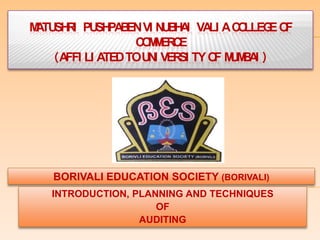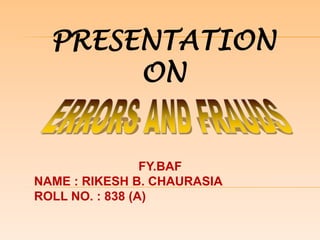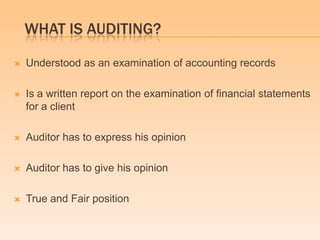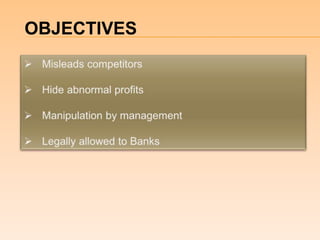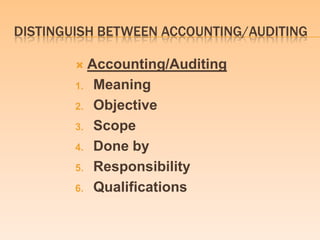METHODS OF AUDITING
- 1. M TU R PU PA EN VI N B A VA A C LLEG O A SH I SH B UHI LI O E F C M ER E OM C (A LI A FFI TED TOU I VER TY O M M A ) N SI F UBI BORIVALI EDUCATION SOCIETY (BORIVALI) INTRODUCTION, PLANNING AND TECHNIQUES OF AUDITING
- 2. PRESENTATION ON FY.BAF NAME : RIKESH B. CHAURASIA ROLL NO. : 838 (A)
- 3. INTRODUCTION OF AUDITING
- 4. EVOLUTION The term audit is derived from the Latin term „audire,‟ which means to hear. Auditing is as old as accounting. Landlords used to “hear” the position of accounts In India the companies Act 1913 made audit of company accounts compulsory.
- 5. DEFINITION Prof. L.R.Dicksee. "auditing is an examination of accounting records undertaken with a view to establish whether they correctly and completely reflect the transactions to which they relate.
- 6. WHAT IS AUDITING? Understood as an examination of accounting records Is a written report on the examination of financial statements for a client Auditor has to express his opinion Auditor has to give his opinion True and Fair position
- 7. BASIC PRINCIPLES OF AUDITING Integrity Objectivity and Independence Skill and Competence Confidentiality Work performed by others
- 8. CONTINUE…… Planning Documentation/Working papers Audit evidence Accounting system and Internal Control Audit conclusion
- 9. OBJECTIVES OF AUDITING The objective of audit can be divided into two parts: Primary Secondary objective objective
- 10. PRIMARY OBJECTIVE (MAIN OBJECTIVE) To produce a report by the auditor of his opinion of the truth and fairness of financial statements so that any person reading or using them can have belief in them.
- 11. SECONDARY OBJECTIVES 1. To detect errors and frauds 2. To prevent errors and frauds by the deterrent and moral effect of the audit. 3. Secondary objective is ensure the final accounts tally with books of accounts.
- 12. WINDOW DRESSING In accounting , window dressing means showing the books of accounts attractive. It means showing the wrong picture. Amounts of profits and net worth are overstated in the Liabilities. It is an act making a company look financially then it really is. It is technique in accounting that is used to present the financial position of the company in a favorable.
- 13. MERITS OF WINDOW DRESSING 1. Existing Shareholders take advantage of window dressing. 2. There is considerable scope for window dressing in company‟s published accounts.
- 14. DEMRITS OF WINDOW DRESSING
- 15. SECRET RESERVES Reserve means part of the profits kept aside for the future use. Secret Reserve means part of the profits secretly kept aside for the future use.
- 16. OBJECTIVES
- 17. HARMS OF SECRET RESERVES No true & fair view Harmful to investors Undue benefit to management Withdrawal of Profit No check on asset
- 18. DISTINGUISH BETWEEN ACCOUNTING/AUDITING Accounting/Auditing 1. Meaning 2. Objective 3. Scope 4. Done by 5. Responsibility 6. Qualifications
- 20. INTRODUCTION The primary objectives of Audit is to Determine whether the books of accounts are TRUE & FAIR. The secondary objectives are Detection & Prevention of Errors & Frauds. Accounts are said to be True and Fair only when they are from errors and frauds.
- 21. TYPES OF ERRORS There are two types of Errors Errors of Clerical Errors Principle
- 22. TYPES OF FRAUDS There are two type of Frauds: Manipulation Misappropriations of Records
- 23. AUDITORS RESPONSIBILITY TOWARDS ERRORS AND FRAUDS Prime responsibility of management Incidental objective of audit Probability of Non-detection of errors & frauds Indicators of errors & frauds CARO 2003

